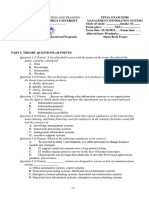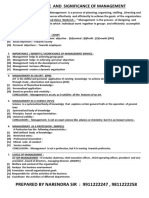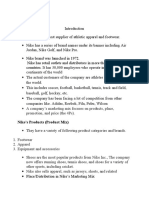Chapter 2 Gaining Competitive Advantage Through Information Systems
Chapter 2 Gaining Competitive Advantage Through Information Systems
Uploaded by
Ashikin AzlinCopyright:
Available Formats
Chapter 2 Gaining Competitive Advantage Through Information Systems
Chapter 2 Gaining Competitive Advantage Through Information Systems
Uploaded by
Ashikin AzlinOriginal Title
Copyright
Available Formats
Share this document
Did you find this document useful?
Is this content inappropriate?
Copyright:
Available Formats
Chapter 2 Gaining Competitive Advantage Through Information Systems
Chapter 2 Gaining Competitive Advantage Through Information Systems
Uploaded by
Ashikin AzlinCopyright:
Available Formats
Nur Khazanah Nashuha Binti Roslie
D20171077120
Tutorial 2
Chapter 2 Gaining Competitive Advantage Through Information Systems
MCQ and TRUE/FALSE Question
1. C 11. C 21. E 31. C 41. A 51. FALSE
2. E 12. A 22. B 32. D 42. TRUE 52. TRUE
3. A 13. A 23. C 33. D 43. FALSE 53. TRUE
4. A 14. C 24. D 34. E 44. FALSE 54. TRUE
5. B 15. D 25. C 35. E 45. TRUE 55. TRUE
6. D 16. A 26. A 36. B 46. TRUE 56. TRUE
7. E 17. A 27. E 37. A 47. TRUE 57. TRUE
8. A 18. D 28. A 38. E 48. TRUE 58. FALSE
9. A 19. B 29. B 39. E 49. TRUE 59. TRUE
10.A 20. C 30. B 40. D 50. TRUE 60. TRUE
Discussion
61) The difference between being effective and being efficient are :
i) Effective
- referring to adequate to accomplish a purpose; producing the intended or expected
result.
- doing the right things
ii) Efficient
- referring to performing or functioning in the best possible manner with the least
waste of time and effort.
- doing things right.
62) The differences between operational-level decision making and tactical-level decision
making by managers in organizations are stated below :
i) Operational decisions:
- relate to day-to-day op-erations of the enterprise.
- have a short-term horizon as they are taken repetitively.
- based on facts regarding the events and do not require much of business judge-ment.
- taken at lower levels of man-agement.
- the information is needed for helping the manager to take rational, well informed
decisions, information systems need to fo-cus on the process of managerial decision
making.
ii) Tactical- level decisions:
- relate to the implementation of strategic decisions.
- directed towards developing divi-sional plans, structuring workflows, establishing
distribution chan-nels, acquisition of resources such as men, materials and money.
- taken at the middle level of management.
Nur Khazanah Nashuha Binti Roslie
D20171077120
Tutorial 2
63) There are differences between tactical-level decision making and executive-level
decision making by managers in organizations such as :
i) Tactical- level decisions:
- relate to the implementation of strategic decisions.
- directed towards developing divi-sional plans, structuring workflows, establishing
distribution chan-nels, acquisition of resources such as men, materials and money.
- taken at the middle level of management.
ii) Strategic/executive-level decisions:
- major choices of actions and influence whole or a major part of business enterprise.
- contribute directly to the achievement of common goals of the enterprise.
- have long-term implications on the business en-terprise.
- Unstructured,
- based on partial knowledge of the environmen-tal factors which are uncertain and
dynamic. taken at the higher level of management.
64) The specific types of information systems that correspond to each organizational level
are different for each such as
i) at the strategic level they implement executive support systems (ESS)
ii) at the operational level they implement transaction processing systems (TPS)
Systems at each level in turn are specialized to serve each of the major functional areas.
Thus, the typical systems found in organizations are designed to assist workers or managers
at each level and in the functions of sales and marketing, manufacturing and production,
finance and accounting, and human resources.
65) Porter's primary competitive forces that analyze the competition within an industry are :
i) Competitive rivalry
ii) Bargaining power of suppliers
iii) Bargaining power of customers
iv) Threat of new entrants
v) Threat of substitute products or services
66) Functional information systems (IS) such as accounting IS, financial IS, Human
resource IS, marketing IS and operational IS are implemented in the 3 level of
organizational.
They use those information system:
In operational level to organize
- Payroll processing
- Cash management
- Employee skill inventory
- Pricing and sales analysis
- Manufacturing resource utilization
Nur Khazanah Nashuha Binti Roslie
D20171077120
Tutorial 2
In functional level to organize
- Order processing
- Financial forecasting
- Compensation analysis
- Sales force automation
- Inventory management
In strategic level to organize
- ration analysis
- portfolio management
- personnel forecasting
- advertising and promoting planning
- manufacturing resource planning
You might also like
- The Handbook of Market Intelligence: Understand, Compete and Grow in Global MarketsFrom EverandThe Handbook of Market Intelligence: Understand, Compete and Grow in Global MarketsNo ratings yet
- MG101 Final Exam PDFDocument16 pagesMG101 Final Exam PDFAlvin Chand100% (1)
- Chapter 2 Gaining Competitive Advantage ThroughDocument4 pagesChapter 2 Gaining Competitive Advantage ThroughAshikin AzlinNo ratings yet
- BST 200 Ques MCQDocument23 pagesBST 200 Ques MCQPrathisha XII D1No ratings yet
- Im & Saftey QPDocument48 pagesIm & Saftey QPiqbalNo ratings yet
- Management Accounting Group Assignmemt (Group 2) Msc. Accounting and Finance Sunyani Study CenyerDocument5 pagesManagement Accounting Group Assignmemt (Group 2) Msc. Accounting and Finance Sunyani Study CenyerBrow SimonNo ratings yet
- Diary 1Document13 pagesDiary 1Brighton1990No ratings yet
- Subject Code: MC0076 Subject Name: Management Information Systems Credits: 4 Marks: 140Document3 pagesSubject Code: MC0076 Subject Name: Management Information Systems Credits: 4 Marks: 140najirahmedNo ratings yet
- Model Qp-Management Information SystemsDocument23 pagesModel Qp-Management Information Systemsadnan_an2020No ratings yet
- BM - Supporting NotesDocument6 pagesBM - Supporting NoteschaitalipshahNo ratings yet
- MS Business Studies-XII Set-ADocument8 pagesMS Business Studies-XII Set-Aठाकुर रुद्र प्रताप सिंहNo ratings yet
- Final ExaminationDocument4 pagesFinal ExaminationSaifullah SiddiquiNo ratings yet
- Winter 2014 Model Answer PaperDocument16 pagesWinter 2014 Model Answer PaperDiyaNegiNo ratings yet
- Scpm Set b Icai Bos Mcqs CompiledDocument91 pagesScpm Set b Icai Bos Mcqs Compiledbhoyarmrudul92No ratings yet
- Mis Test 2 PDFDocument23 pagesMis Test 2 PDFAA BB MMNo ratings yet
- Chapter 1-Basics of MNGT Final ModifiedDocument35 pagesChapter 1-Basics of MNGT Final ModifiedGech MNo ratings yet
- ES 303 Quiz SY 2023 2024Document8 pagesES 303 Quiz SY 2023 2024Maria Genelynne SalisidNo ratings yet
- MS BST 6Document7 pagesMS BST 6Sulekha PatiNo ratings yet
- Quiz - Chap 12Document3 pagesQuiz - Chap 12Dương Khanh PhạmNo ratings yet
- Managerial Accounting Chapter 1 ExercisesDocument3 pagesManagerial Accounting Chapter 1 ExercisesAngelica Lorenz100% (2)
- Intermediate Examination Syllabus 2016 Paper 9: Operations Management & Strategic Management (Omsm)Document7 pagesIntermediate Examination Syllabus 2016 Paper 9: Operations Management & Strategic Management (Omsm)Hemmu sahuNo ratings yet
- Exam Guide Book Sample Copy Master of Business Administration (Mba) Semester - I Mba101/Mb0038 - Management Process & Organizatonal Behaviour - 4 Credits (Book Id B1621) Model Question PaperDocument45 pagesExam Guide Book Sample Copy Master of Business Administration (Mba) Semester - I Mba101/Mb0038 - Management Process & Organizatonal Behaviour - 4 Credits (Book Id B1621) Model Question PaperReema UpadhyayNo ratings yet
- ENMADocument50 pagesENMAZoren Jovillanos EmbatNo ratings yet
- Model Answer Summer 2014Document17 pagesModel Answer Summer 2014DiyaNegiNo ratings yet
- Mba 101 MB0051Document90 pagesMba 101 MB0051hsWSNo ratings yet
- Management MCQDocument40 pagesManagement MCQGabriela MaerskNo ratings yet
- MQP MBF203Document14 pagesMQP MBF203Nishanth Kumar VaishnavNo ratings yet
- MIS AsstDocument4 pagesMIS AsstAbubeker AliNo ratings yet
- TVET Management RevT New, 2021Document123 pagesTVET Management RevT New, 2021kabtamu mamoNo ratings yet
- University of Cebu: PlanningDocument16 pagesUniversity of Cebu: PlanningInbalidNo ratings yet
- Đề Thi IS300 Ngày 21 Tháng 11 Năm 2021Document4 pagesĐề Thi IS300 Ngày 21 Tháng 11 Năm 2021thủy anh phạmNo ratings yet
- MBA 101 of Business Administration Guide BookDocument74 pagesMBA 101 of Business Administration Guide BooklalsinghNo ratings yet
- External Job Advert v2Document26 pagesExternal Job Advert v2isempogoNo ratings yet
- BBA 12 - BBA 122 Final Question Fall 19Document5 pagesBBA 12 - BBA 122 Final Question Fall 19LAZINA AZRINNo ratings yet
- Chapter 1Document46 pagesChapter 1Brhane TeklayNo ratings yet
- Mgt502 Quiz, Short Question 1-10Document37 pagesMgt502 Quiz, Short Question 1-10nuzhat.navttcNo ratings yet
- Ib MutualfundfeesDocument89 pagesIb MutualfundfeesashkhanNo ratings yet
- Ca Ipcc - ItDocument82 pagesCa Ipcc - ItIQBAL MAHMUDNo ratings yet
- Quiz 1Document2 pagesQuiz 1chsharjeel789No ratings yet
- Xii BST Support MaterialDocument154 pagesXii BST Support MaterialSamreen Kaur100% (1)
- Mas 01Document8 pagesMas 01Raquel Villar DayaoNo ratings yet
- Mayank 16521Document18 pagesMayank 16521naman kumarNo ratings yet
- 1.3.1 Identify Application Areas of Industrial Management.: (CLO1, PLO2:DK 1 & DK 4)Document4 pages1.3.1 Identify Application Areas of Industrial Management.: (CLO1, PLO2:DK 1 & DK 4)Siti FatimahNo ratings yet
- C3 Part BDocument10 pagesC3 Part BMohammad AamirNo ratings yet
- Strictly Confidential: (For Internal and Restricted Use Only)Document27 pagesStrictly Confidential: (For Internal and Restricted Use Only)bhaiyarakeshNo ratings yet
- Question Bank For Students HR Metrics AnalyticsDocument10 pagesQuestion Bank For Students HR Metrics AnalyticsNandhu Jaanu0% (1)
- Chapter 8Document13 pagesChapter 8Nik Nur MunirahNo ratings yet
- Cbse 12 BST PT 1 (Mav)Document2 pagesCbse 12 BST PT 1 (Mav)Suhaani KhandharNo ratings yet
- TQM Part 1Document5 pagesTQM Part 1amelia1953garciaNo ratings yet
- Narendra Sir MergedDocument112 pagesNarendra Sir MergedShaurya GosainNo ratings yet
- 2nd Puc Business Studies Passing Package Eng Version 2019-20 by Joy KVDocument14 pages2nd Puc Business Studies Passing Package Eng Version 2019-20 by Joy KVsamarthbhiradiNo ratings yet
- Orca - Share - Media1668708677062 - 6999071479038116413 2Document11 pagesOrca - Share - Media1668708677062 - 6999071479038116413 2Lara AbuDayehNo ratings yet
- SMB101Document21 pagesSMB101KausikNo ratings yet
- MGT 2010 Sem 2 15-16 PDFDocument12 pagesMGT 2010 Sem 2 15-16 PDFsapik zirafNo ratings yet
- Paper20C Set1 SolDocument13 pagesPaper20C Set1 SolAksaya CaNo ratings yet
- Pre Board Class XII Business StudiesDocument8 pagesPre Board Class XII Business StudiesShubham100% (7)
- Achieving Business Value from Technology: A Practical Guide for Today's ExecutiveFrom EverandAchieving Business Value from Technology: A Practical Guide for Today's ExecutiveNo ratings yet
- CIO Best Practices: Enabling Strategic Value with Information TechnologyFrom EverandCIO Best Practices: Enabling Strategic Value with Information TechnologyRating: 4 out of 5 stars4/5 (1)
- Wiley CMAexcel Learning System Exam Review 2015: Part 2, Financial Decision MakingFrom EverandWiley CMAexcel Learning System Exam Review 2015: Part 2, Financial Decision MakingNo ratings yet
- Wiley CMAexcel Learning System Exam Review 2015: Part 1, Financial Planning, Performance and ControlFrom EverandWiley CMAexcel Learning System Exam Review 2015: Part 1, Financial Planning, Performance and ControlNo ratings yet
- Jitendra ResumeDocument2 pagesJitendra ResumejitubatistaNo ratings yet
- Srishti MehraDocument64 pagesSrishti MehraSwati KatariaNo ratings yet
- Presentation ON: Life'S Good of LGDocument20 pagesPresentation ON: Life'S Good of LGGaurav Gangwar SuryaNo ratings yet
- CV Incognito, Brian MBADocument4 pagesCV Incognito, Brian MBABRIAN INCOGNITONo ratings yet
- University of Mumbai: (Summer)Document1 pageUniversity of Mumbai: (Summer)Rishu TripathiNo ratings yet
- Change4Life Case Studies Leeds FINAL PDFDocument5 pagesChange4Life Case Studies Leeds FINAL PDFblacNo ratings yet
- MBA - ICFAI UniversityDocument21 pagesMBA - ICFAI UniversitysuryayuaNo ratings yet
- Business Ethics - Wikipedia, The Free EncyclopediaDocument39 pagesBusiness Ethics - Wikipedia, The Free EncyclopediaBaljinder KaurNo ratings yet
- Nick Mulhall - MAS2011 PresentationDocument20 pagesNick Mulhall - MAS2011 Presentationjourney9No ratings yet
- Cannabis Investor Volume 10Document106 pagesCannabis Investor Volume 10moscowstarNo ratings yet
- UNILEVER Marketing StrategyDocument5 pagesUNILEVER Marketing Strategyanand.tvsmNo ratings yet
- Competitive Strategies For Market LeadersDocument24 pagesCompetitive Strategies For Market LeadersAmir KhanNo ratings yet
- Location StrategiesDocument34 pagesLocation Strategiesastrid_widayaniNo ratings yet
- Monopolistic CompetitionDocument21 pagesMonopolistic CompetitionManu K AnujanNo ratings yet
- Social Media Marketing in IndiaDocument10 pagesSocial Media Marketing in IndiaMahi KalaiNo ratings yet
- Summary Nike 4 PDocument4 pagesSummary Nike 4 PkavitaNo ratings yet
- Advertising: I'M Lovin' It!Document7 pagesAdvertising: I'M Lovin' It!chris andersonNo ratings yet
- S D O, P.H Maintanance P H Divn.1 UNIT-5 Bhubaneswar Orissa 751001 P O StampDocument3 pagesS D O, P.H Maintanance P H Divn.1 UNIT-5 Bhubaneswar Orissa 751001 P O StampRamachandra SahuNo ratings yet
- Approval SheetDocument6 pagesApproval Sheet2K GAMERNo ratings yet
- KPIs For Di MarketingDocument6 pagesKPIs For Di MarketingS TompulNo ratings yet
- Item Matrix For SAP Business OneDocument4 pagesItem Matrix For SAP Business OneCitiXsys TechnologiesNo ratings yet
- Post Graduate Diploma in Marketing Management: A Dissertation Report ONDocument53 pagesPost Graduate Diploma in Marketing Management: A Dissertation Report ONkartick rajNo ratings yet
- Blue NileDocument11 pagesBlue NileShane Henricus100% (2)
- How To Define Your Tone of Voice (Template) Fitxategiaren KopiaDocument3 pagesHow To Define Your Tone of Voice (Template) Fitxategiaren KopiaKarolina BaskaranNo ratings yet
- Walmart S War On MainstreetDocument9 pagesWalmart S War On MainstreetRamo1107No ratings yet
- Critical Success Factors Telecommunication Network Equipment Procurement Projects MTN NigeriaDocument42 pagesCritical Success Factors Telecommunication Network Equipment Procurement Projects MTN NigeriaMigwiJ.Mwangi100% (1)
- Bank Al Falah Matrix FinalDocument4 pagesBank Al Falah Matrix FinalSajid AliNo ratings yet
- Sanger, Chris - Sanger For State Representative - 1767 - E - in - KindDocument2 pagesSanger, Chris - Sanger For State Representative - 1767 - E - in - KindZach EdwardsNo ratings yet
- Saiful Islam Jafri: ExperienceDocument3 pagesSaiful Islam Jafri: ExperienceJavier RuizNo ratings yet
- Screenshot 2024-10-23 at 11.50.04 AMDocument15 pagesScreenshot 2024-10-23 at 11.50.04 AMtharuni vakatiNo ratings yet

























































































